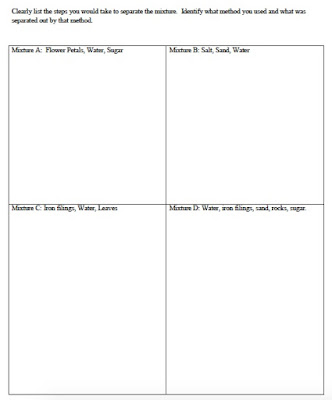This is a great unit with my seventh graders. It's easy to start because the kids usually remember
something about photosynthesis from elementary school. If not, they already know that plants need sunlight and water. This is not a very long unit. Maybe 2-3 weeks.
The goals for this unit are:
- The students will be able to write the word equations for photosynthesis and respiration
- Photosynthesis is
"sunlight + water + carbon dioxide --> glucose + oxygen."
- Respiration is
"glucose + oxygen --> ATP energy + water + carbon dioxide."
- The students will identify that photosynthesis occurs in the chloroplast and respiration occurs in the mitochondria.
- The students will identify that they are reverse/opposite reactions.
- The students will understand the words "reactant" and "product."
- The students will use their knowledge of the reactions to answer various questions.
Some (not all) of the activities we do for this unit:
1. Acting it out!
I have little cut outs from card stock paper (nothing fancy!) and one kid is assigned a role (either a reactant or a product, or the plant). I make up a little narrative and the kids have to listen for their part and come in and "act" it out appropriately. It's just a fun little activity, but it gets the kids up and moving and helps them visualize what's going on.
This class actually happened on Halloween this year, which was perfect. None of my kids dressed up for school (sad!) so I told them I had brought their costumes: sunlight, water, carbon dioxide, glucose, oxygen, and a plant. haha.
2. Worksheet practice:
Worksheet practice throughout the unit, used in whatever order makes sense for that year and how that group of students is progressing. This is only two of my worksheets. The others ended up as a mix of things from other sources that are not directly mine, so I'm not putting them on here. I know I've got others, but they're probably on my work computer (I'm on my home computer right now). If I find them I'll put them on here, too.
(Get the worksheet at the bottom of this page)
Worksheet A: Identification
WORKSHEET B: Chemical Formulas
I use this more for my 8th graders who are working on the periodic table and interpreting chemical formulas. It reinforces what they learned last year and applies their new knowledge to familiar situations. Link for worksheet at the bottom of this page.
3. WALL-E Day!
 |
| from google image search |
No, we don't watch the whole movie, although that would be awesome and less planning for me! But there's no time to do that and it would be a waste when a few clips can aid your discussion quite nicely. The kids love this class because we get to watch some of WALL-E and understand that it actually has real science in it!
The clips I show (I may or may not show all of them)
1.
Opening Scene
2.
WALL-E's day at work
3.
WALL-E finds a plant
4.
WALL-E first date scene (EVE takes the plant)
5.
WALL-E in space
6.
Human dystopia
7.
Directive A113
8.
End Credits (I show this so we can talk about what the people are doing and how the earth changes)
WORKSHEET FOR WALL-E (link at bottom of page)
4. Yeast Lab:
 |
| It's hard to tell, but the red balloon is a little bigger. |
It would be fun to also do a plant lab, but I haven't figured out how to do one of those in our small little country school with limited resources. So yeast lab is how we'll have to do it! The kids love watching the balloons fill up. I use this towards the end of the unit to really push their thinking and application of what they have learned. Deeper level questions like "How can you prove the yeast are doing respiration and not photosynthesis?" (possible answers: we added sugar as a reactant; they're not green, so they don't have chloroplast; etc.) "What is filling up the balloon and how do you know?" (CO2, because it's undergoing respiration). My kids have a harder time with these questions that make them think. It takes more prodding as a teacher to get these SPED kids to that level. We can get there, it just takes longer.
LAB WORKSHEET (link at bottom of page)
And that's photosynthesis and respiration. We do a lot of group lecture, discussion, and practice. I draw a lot on the board and I have them practice the equations every day. Today was our last day on the unit, but we have two days of review before our cell test (the overall unit), so we'll have some talk on it before the test next week.
























































